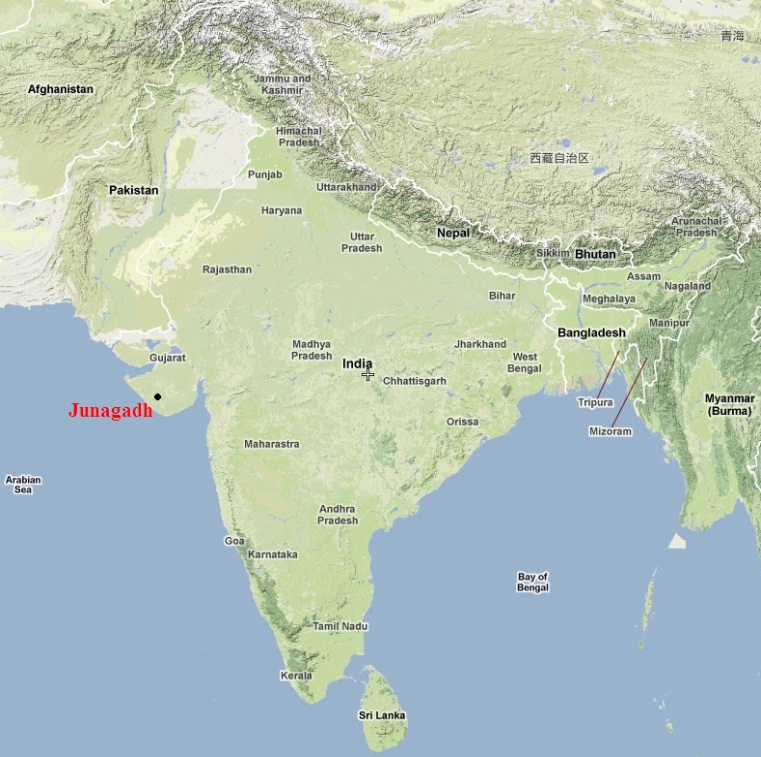Junagadh District 12
Introduction 12
Physical Geography 20
Geology and Soils 21
Climate 23
Forests 23
Administration 25
Population 28
Infrastructure 29
Agriculture 30
Industries 34
Trade 35
Junagadh City 36
Introduction 36
Climate 41
Administration 42
Non-Government Organisations 45
Population 50
Media 55
Infrastructure 55
Schools 60
Industries 60
Condition of City’s Monuments 62
Chapter preview (first two pages only):
Junagadh District
Introduction
The Junagadh District is located on the Kathiawar or Saurashtra Peninsula in western Gujarat, with the city of Junagadh as its administrative headquarters. The district is surrounded by the Rajkot District (north), Porbandar District (north-west) and Amreli District (east). To the south is the Arabian Sea. The total area of the district is 8782.1 km2 of which the urban area is 410 km2.
Figure 1. Map of Indian subcontinent showing the location of Junagadh (from Google Maps 2010).
According to Sankalia (1967, page 229): ‘Surastra as an old name of Kathiawad is at least 2287 years old, known as it was in the time of Chandragupta Maurya (c. 320 B.C.). From a 700-year later record at Junagadh we know that there were possibly many Surastras, or that Surastra was split up into northern, southern, eastern and western Surastra, and therefore the viceroy (Rastriya) of Skandagupta at Girinagara is called the lord of all the Surastras (akhilan Surastran).’
Yagnik and Sheth (2005, page xi) noted an early expression of pride for the impressiveness of Gujarat: ‘…Gujarati pride can be seen in the fourteenth-century Sanskrit poem ‘Nabhinandan-jinoddhar Prabandh’ by [a] Jain monk, Kakkasuri. He glorified Gurjardesh in the poem, describing in detail the flora of the land, its prosperous ports and the wealth of those who conducted business there. Interestingly, he indicated the boundaries of Gurjardesh through a catalogue of the religious places that were situated within the region, which corresponds roughly to Gujarat of today.’
Mallison (2010) said that: ‘distinctive feature[s] of Saurashtra are the wealth and the originality of its religious traditions. It provides shelter on its soil for sanctuaries known all over India like Dwarka or Somnath, Jaina holy places of prime importance like Girnar and Palitana, two of the twelve jyotirlings (jyotirliṅgam), Somnath and Nagesvar, and the puranic geography of Saurashtra is eloquent about the antiquity of the fact that this province was a part of the magnificent tradition of classical Hinduism. Much less well known is the extraordinary wealth of holy men and local cults, its dense network of small popular sanctuaries covering the country. They all belong to what the local authors call loka-dharma, popular religion.’
Mr Claude Hill, Agent to the Governor-General in Kathiawar (1908–1912), commented about the Province of Kathiawar (Ryley 1913), that: ‘The study of its political history is one of the most interesting chapters in the history of India… the Peninsula of Kathiawar presents within a very small geographical limit a greater variety of race, creed and place of origin of its population than almost any other area of similar extent on the surface of Asia.’
The Sorath area, of which Junagadh has long been the capital, is a notable patch of good quality agricultural land. A local ballad mentions that ‘In Sorath are jewels five: horses, rivers and women; Somnath the fourth; Fifth Hari’s presence’ (Soundara Rajan 1985). Shastri (2000, page 175) commented on the high population density of land in the region around Junagadh during the Maitraka period (458–788 AD), when the capital of Saurashtra was located at Valabhi: ‘A survery of the maps of this period indicates that the location of the identified places mentioned in the royal grants of land implies density of

I need all part in gujrati
Contact me
Hi Hitesh
I also need all parts in Gujarati. Maybe you could help with translating? Contact me here.